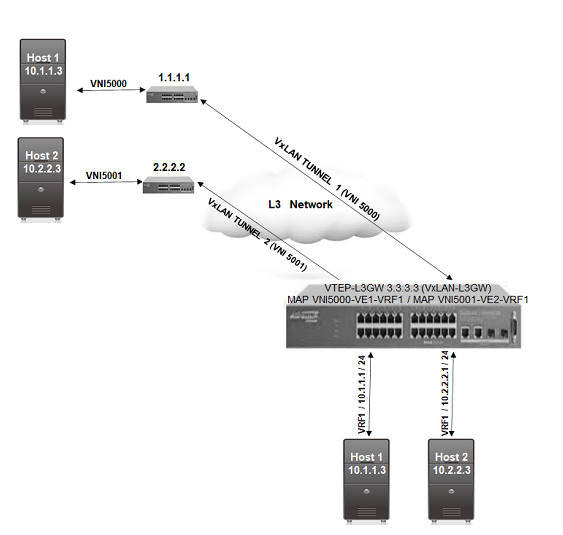VxLAN Layer 2 gateway overview
SLX-OS devices can act as a Layer 2 gateway.
A split-horizon topology is supported. As there is no tunnel-to-tunnel flooding of broadcast, unknown unicast, and multicast (BUM) traffic, all nodes participating in the VLAN must be connected through VxLAN tunnels.
The following figure illustrates an example Layer 2 gateway topology.

In this topology, device 1, 2, and 3 are all VxLAN Layer 2 gateways. On the device 3, tunnel 1 and tunnel 2 are mapped to VLAN 5, which has two hosts, i.e., MAC 3 and MAC 4 and it is connected to two other hosts of device 1 and device 2, which connect to hosts MAC 1 and MAC 2, respectively, through VxLAN tunnels 1 and 2, respectively. If MAC 3 needs to establish traffic to MAC 1, initially there will be BUM flooding and upon a response from MAC 1, where MAC 1 is learned through tunnel 1. Subsequently the traffic goes directly from MAC 3 to device 1 on tunnel 1. The traffic in the reverse direction comes from device 1 that is decapsulated, and goes to MAC 3.
VLANs on each node are extended through the common Virtual Network Instance (VNI) 5000. The MAC addresses of the local hosts are learned on access points and the MAC addresses are learned on the VxLAN tunnels.
| Device | IP address | Mapping |
|---|---|---|
| 1: SLX 9540 series | 1.1.1.1 | VNI 5000 < > VLAN 10 |
| 2: VDX 6740 series | 2.2.2.2 | VNI 5000 < > VLAN 20 |
| 3: SLX 9540 series | 3.3.3.3 | VNI 5000 < > VLAN 5 |

